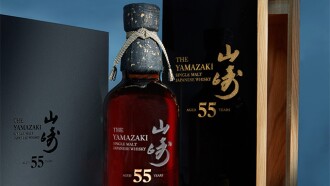L ed by the Yamazaki 55 – the oldest and most valuable whisky ever bottled in Japan – Japanese whisky is now the second most valuable whisky category on the secondary market, following Scotch. Having been initially released in 2020 via ballot for only JP¥3.3 million (around $31,000), this single-malt bottle from Suntory has since achieved prices up to $780,000 at auction, surpassing the Karuizawa 1960 as the most expensive Japanese whisky. But Japanese whisky hasn’t always commanded such high prices.
The Origins of Japanese Whisky
The country’s love of whisky began in 1853, when a US naval officer named Matthew C. Perry arrived on Japanese shores near the end of the Edo period. The Tokugawa Shogunate enforced a strict rule of isolation, meaning that no Japanese nationals could leave and no foreign visitors could enter. Commodore Perry brought peace offerings – namely a white flag and a cask of American whiskey (presumably rye) – and the Shogunate was wooed by his approach to negotiation. As laws concerning isolation relaxed, whisky imports began. This dark spirit enchanted the Japanese palate and encouraged local brewers and distillers to re-create the foreign elixir.

The genesis of Japanese whisky distillation can be largely attributed to two men. Shinjiro Torii, an Osaka-born apprentice pharmacist and wine merchant, began his journey into spirits with his blend Torys Whisky in 1919. Torys was the result of a happy accident; Shinjiro forgot about some blending alcohol he’d stored in a wine cask. Bottled and sold, it proved so popular that Shinjiro saw the spirit’s potential. In the same year, White Oak Distillery, a part of Eigashima Shozu, received the country’s first license to distil whisky (although it didn’t begin production until the ’60s). However Shinjiro knew almost everyone in Japan at the time lacked the know-how of Scottish distillers.
That is, except for Masataka Taketsuru. The son of a sake brewer in Hiroshima, Taketsuru studied chemistry and developed a great knowledge of fermentation. Later employed at Kansai’s Stetsu Shozu – an industrial distillery producing imitation Scotch cask – he realized that the quality of their product (essentially flavoured shōchū) didn’t live up to the quality of Scottish imports. And so he traveled to Scotland to learn.
Masataka Taketsuru spent three years there studying chemistry at Glasgow University and working at Longmorn, Bo’ness and Hazelburn Distilleries. He returned to Japan in 1920 with Rita Taketsuru (née Cowan), his wife, and a journal entitled “Report of Apprenticeship: Pot Still Whisky” (known to whisky fans as “Taketsuru Note”). The former was his muse, and the latter became the ultimate manual for Japanese whisky-making.

Suntory’s Yamazaki Distillery is Born
Three years after returning to Japan, Taketsuru entered Shinjiro Torii’s employ as the whisky-maker at Kotobukiya, now known as Suntory. After a hunt for a perfect location for their distillery, they landed on the village of Yamazaki in 1923. And on 11 November 1924, Suntory’s first Yamazaki whisky ran from their stills.
Throughout the years, whisky’s popularity has risen and fallen in Japan, much as it has in Scotland. During years of prosperity, new distilleries appeared. Taketsuru left Kotobukiya to found Dainipponkaju (now known as Nikka), and various others followed in its wake. Distilleries such as Karuizawa and Hanyu have come and gone with whisky’s cyclical popularity.
The Paramount of Japanese Whisky: Yamazaki 55 Year Old Single Malt

In fallow years, many brands released their most aged stocks to win back favor in the global market. A meteoric rise in whisky prices has led to new releases rocketing in value, and we now find ourselves in a boom period for Japanese single malt whisky.
Suntory’s humble Yamazaki 18 Year Old used to sell on supermarket shelves for $50; it now auctions at Sotheby’s for as much as $1,875. Aged whisky casks are now quite limited in Japan – so much so that Suntory whisky’s aged statement brands have either been discontinued or are only released on highly limited allocation.
An extremely rare Japanese whisky, Yamazaki 55 is the preeminent single malt whisky from this scarce supply, and it sits in a league of its own. This Suntory whisky epitomises the key elements collectors search for in a collectible single malt whisky: dark, heavily sherried whisky released in limited numbers with a very high-age statement. This is an example of when price is matched not just by rarity, but by quality.







